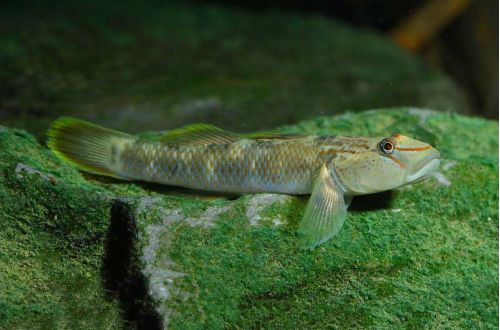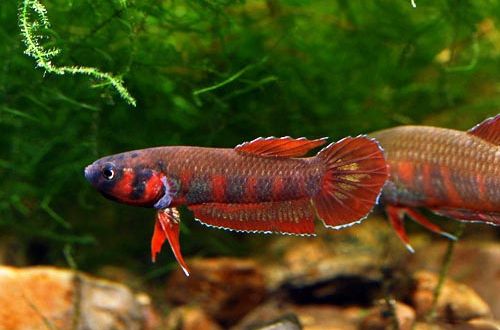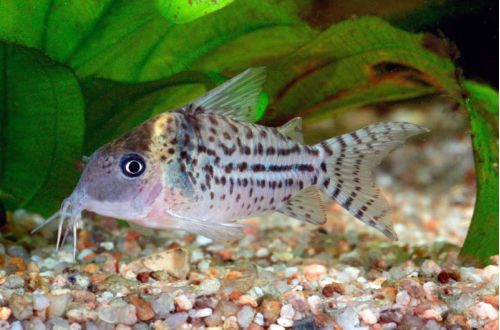
Taiwanese goby
The Taiwanese goby, scientific name Rhinogobius nantaiensis, belongs to the (Goby) family. As the name implies, the fish comes from the island of Taiwan, located 180 km east of the coast of China. Inhabits shallow mountain rivers and fast-flowing streams.

Contents
Description
Adults reach a length of 5–6 cm. The fish has an elongated body with a large head. The eyes are set high on the crown. The coloration is blue-gray with red edging of the scales. A pair of red stripes are visible on the head.
Males and females are similar to each other. Male individuals differ only in the presence of a white first ray on the dorsal fin.
Behavior and Compatibility
Males are very temperamental, arranging skirmishes for territory and the attention of females. However, the apparent hostility is only a visible demonstration of competition and is harmless. It is recommended to keep at least two males and two females in the aquarium so that the males are in constant tone. Otherwise, the males become inactive and lose their color.
Since the Taiwan Goby lives in the bottom layer and has a modest size, it cannot be combined with larger and more territorial species. Also, bad company will be with fish occupying a similar ecological niche, such as Shistura.
Compatible with fish that live in the water column or near the surface, able to live in moderate water currents, such as zebrafish, common cardinal and Vietnamese cardinal, most viviparous species, tetras, etc.
Brief information:
- The volume of the aquarium – from 50 liters.
- Temperature – 18-28°C
- Value pH — 6.0–8.0
- Water hardness – soft to medium hard (5-15 dGH)
- Substrate type — stony
- Lighting – moderate
- Brackish water – no
- Water movement – moderate or strong
- The size of the fish is 5–6 cm.
- Nutrition – any feed (after adaptation)
- Temperament – conditionally peaceful
Maintenance and care, arrangement of the aquarium
The optimal size of the aquarium for 4 fish starts from 50 liters. Decor imitating the bottom of a mountain river is welcome in the design – this is rocky soil with boulders and snags placed on it. As plants, it is desirable to use species that can grow on the indicated surfaces (stones, wood), for example, anubias, numerous aquatic mosses and ferns, bucephalandra, etc.
A more complete list of plants growing on snags, stones can be found in the “Aquarium plants” section by ticking the appropriate filter box.
Like most other fish that live in running waters, the Taiwan Goby does not tolerate the accumulation of organic waste and needs clean water rich in oxygen.
A productive filtration system will not only maintain the quality of water at the proper level, it can also create the necessary flow and act as an aerator.
However, don’t rely solely on the filter’s performance. Regular maintenance of the aquarium is a prerequisite for successful maintenance. The minimum set of procedures is as follows: weekly replacement of part of the water with fresh water, removal of accumulated waste (feed residues, excrement, etc.), equipment maintenance.
Food
In nature, they feed on small invertebrates, which they can find on the bottom. In a home aquarium, the daily diet should include live or frozen daphnia, bloodworms, brine shrimp, mosquito larvae. Can be accustomed to alternative foods such as dry food.
Breeding / breeding
Cases of breeding in the home aquarium are not rare. Creation of special conditions for reproduction is not required. Fish lay eggs in shelters, so potential spawning sites should be provided in the aquarium – grottoes, caves, crevices.
The long absence of a male and a female will testify to the imminent appearance of offspring. The couple retreats to a shelter for 2-3 days, where it lays several hundred eggs, attaching them to the surface of the stone. At the end of spawning, the female leaves, and the male remains to guard the clutch for the entire incubation period, which is 9–12 days.
Gobies are extremely prolific, and fry have a high survival rate. A pair of fish will eventually grow into a large population.





